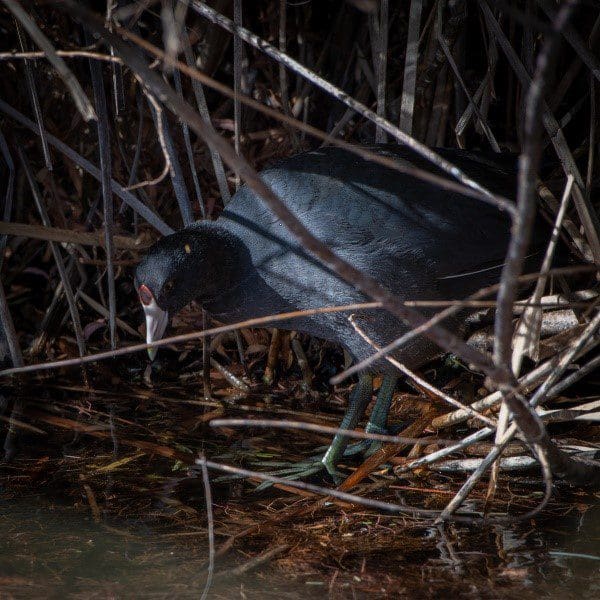The American Coot

WHICH WETLANDS PARK RESIDENT HAS A DISTINCTIVE WHITE SNOOT AND SWIMS LIKE A DUCK… BUT ISN’T?
What on earth is all that splashing and racket in the middle of the pond? Did somebody fall in? Should we call for rescue? Nope. All that noise comes from an American coot (Fulica americana) rushing across the water with beating wings and feet to defend territory, court a mate, or take to the air.
What unusual behavior for a member of the usually shy and secretive rail family of birds! Coots are very conspicuous, very noisy, and familiar to almost everyone who visits a pond of any kind in North or Central America, including golf course water hazards. In Nevada, they are found swimming in company with ducks in city parks from Reno to Las Vegas, as well as almost anywhere they can find a pond, preferably with some emergent vegetation like rushes or cattails. Clark County Wetlands Park has just the habitat they need.
Coots catch the eye, whether swimming or on the water’s edge. They are plump, dark gray birds with very short tails, white bills, and distinctive “lobed” toes that differentiate them from “web-footed” ducks. Even from a distance, they are easy to identify in motion, since they bob or pump their heads as they walk or swim, nodding in unison with the movements of their feet.
Each long, odd-looking coot toe has membranous flaps or “lobes” along both sides. Lobed toes are perfect when swimming or taking flight since they offer extra push against the water. On land, they spread the coot’s weight to prevent sinking on soggy ground. When feeding, they are used to churn up underwater soil in search of tasty morsels of plants or small aquatic animals.
The coots even use the long claws on each toe to parry aggressively with opponents in the struggle for territory, aiming to push them onto their backs and even hold them under water. This behavior has been observed in coots as young as four days old!
If you hear something “noisily splashing about” in a Wetlands Park pond, take a minute to check it out. You may be rewarded with a view of a “rushing” American coot, feet and wings in full motion. In quieter moments, you may notice a coot “nibble-nibble-nibbling” at a piece of food in the tip of its beak, using the taste buds located there to see if the morsel is really as yummy as the bird thought it would be!
– By Chris Leavitt, President; photo by David Walker
Please enjoy these YouTube videos!
Coot running on water (slow motion)
www.youtube.com/watch?v=RKNmm49dRy4
Coot feeding in water
www.youtube.com/watch?v=roW8Obpfydg
Coots battling for territory
